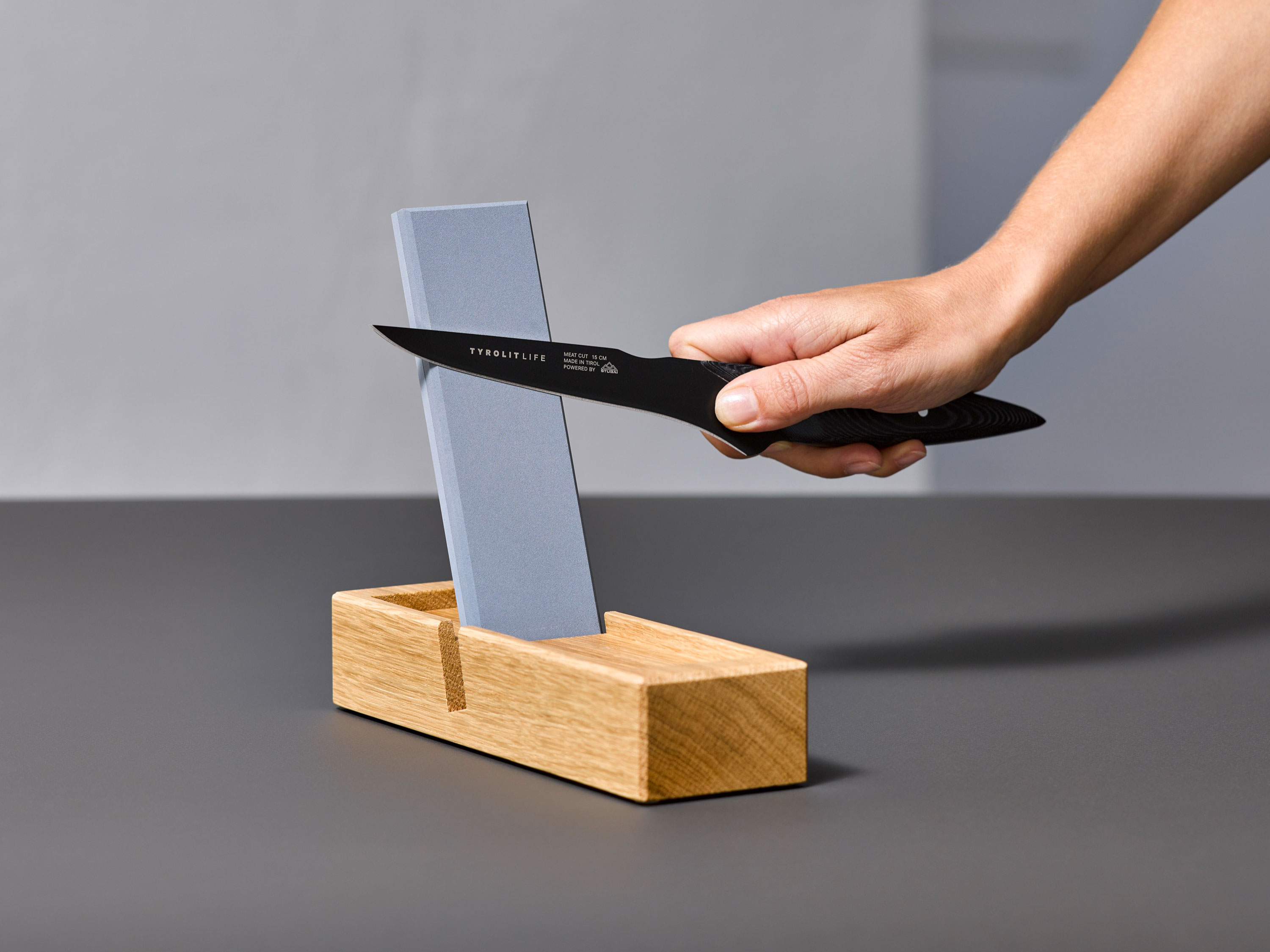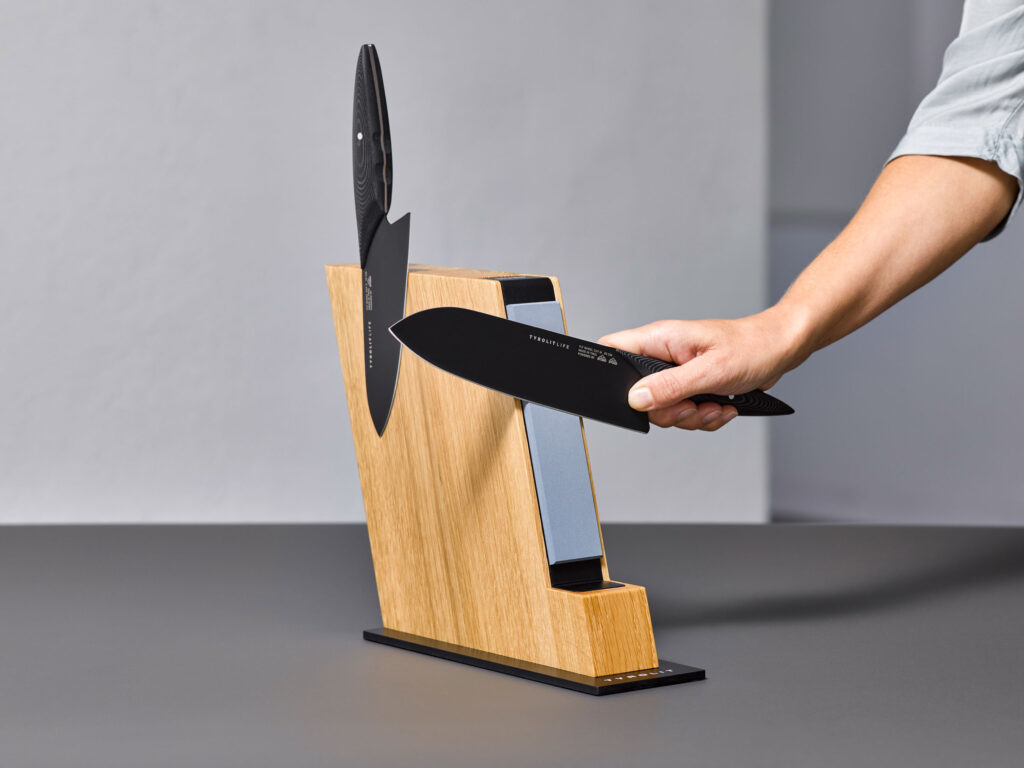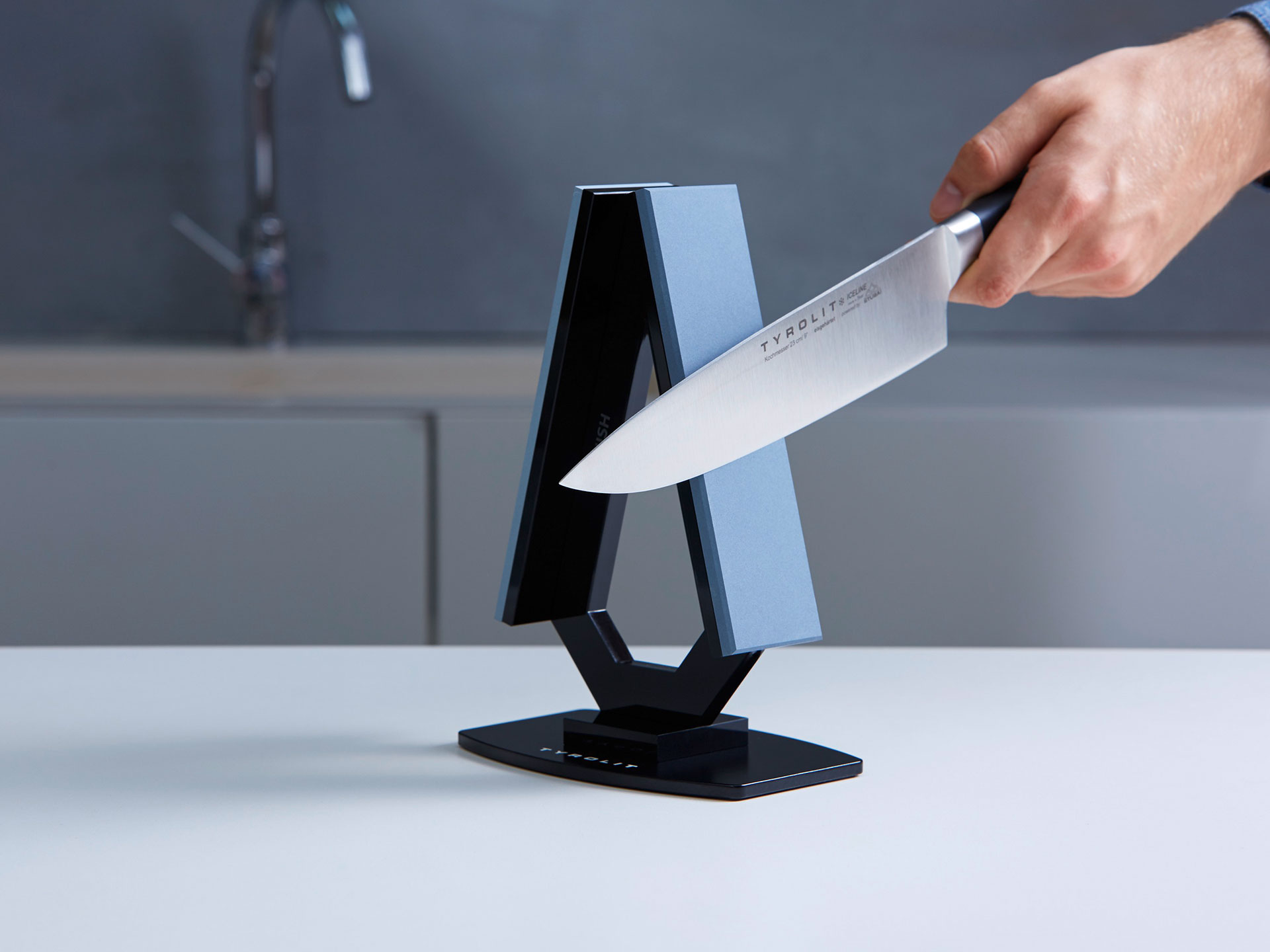Sharpening and Grinding Knives – An Overview of the Best Methods

Knife sharpeners and blade grinders come into play when the knife blade gradually loses its sharpness or has already become dull. This occurs even with the highest quality knives that need to be regularly honed and sharpened. Indeed, sharp blades are indispensable in both the amateur and professional kitchen.
In this post, we will take a look at the different types of knife sharpeners and show you how to get your kitchen knives back to top sharpness. Whether you own a stainless steel chef’s knife or a collection of Japanese knives, we’ll tell you what you need to know about knife sharpeners.
Types of knife sharpeners – you can use them to sharpen your knives
Knife sharpeners are available in various types, each with its own set of pros and cons. Here are some of the most common types of knife sharpeners you can use to hone and sharpen your high-quality kitchen knives – whether you’re a hobbyist or a professional chef.
- Honing steel
- Sharpening steel
- Electric knife sharpener (grinding machine)
- Pull-through sharpener
- Knife sharpener with integrated sharpening stone
What types of knife sharpeners are there?
In this article, we will introduce you to different knife sharpeners and show their strengths and weaknesses. We will also introduce you to the Tyrolit Life knife sharpener and explain what makes the Tyrolean abrasive expert’s approach so special. Find out more now!
5 tips on how to sharpen a knife
Sharpening a knife requires patience, practice, and the right tools. In the following, we will explain step by step how you can get your kitchen knives in top shape.
1. Preparation is half the battle
Proper preparation is the key to a successful sharpening process. Make sure your knife is clean. Clean it thoroughly to remove any dirt or food residue that might interfere with the sharpening process.
Then choose the right sharpening tool for your needs. Depending on the knife, material, and personal preference, this can be a sharpening steel, a sharpening stone, an electric knife sharpener, or another tool.
Also ensure safety when sharpening knives. For example, you need sufficient space and distance to safely sharpen your knife without injuring yourself or others.
Also note that your knife sharpener may sometimes need to be prepared. Just like numerous other sharpening stones, the one from Tyrolit Life needs to be wetted before use to ensure the sharpening process is efficient and gentle.
2. Pay attention to the correct grinding angle
The sharpening angle is a decisive factor when sharpening knives and significantly influences the sharpness and durability of the blade. For European knives, the typical sharpening angle is about 15 degrees. These angles are generally more stable and resistant, which is ideal for kitchen tasks such as cutting meat and vegetables.
Japanese knives, on the other hand, often have a shallower sharpening angle of about 10 degrees. This allows for exceptional sharpness but is more sensitive to wear and requires special care.
The key is to choose the right sharpening angle for your knife and the intended use. Too shallow an angle can make the blade too sensitive, while too large an angle can affect sharpness. Be sure to maintain the correct angle to achieve the desired sharpness.
To make it easier to hit the ideal sharpening angle, Tyrolit Life has developed a knife sharpener with an integrated sharpening angle of 15 degrees. Simply hold the knife perpendicular to the edge of the table and pull its two edges over the coarse and fine sides of the sharpening stone, automatically sharpening at the right angle.
3. Choose the right grit
Selecting the correct abrasive grain size is critical to the sharpening process. For rough grinding, in order to process any damage or very blunt blades, a grain size of around 400 is suitable. Here, material removal is effectively achieved.
For fine sharpening to refine the blade and achieve a smooth edge, a grit of around 800 is ideal. This ensures a sharp and precise cutting edge, perfect for fine work in the kitchen.
Choosing the right grit is crucial to getting your knife to the desired sharpness. Especially handy here are abrasives with different grits, so you can do coarse and fine grinding with just one tool.
Sharpening knives in practice – precision and symmetry make the difference
Knife sharpening requires precision and attention.
Be sure to sharpen the blade symmetrically. This means that both sides of the blade should be given the same angle and number of passes. Also, use the same grit or degree of sharpness on both sides of the blade to achieve uniform sharpness.
Maintain control over the sharpening process and avoid excessive material removal, which could damage the blade. Rushing is not advisable when sharpening. Take the time to thoroughly work on each side. Consistent pressure and maintaining a constant angle are essential.
5. Resharpen and hone kitchen knives – best done regularly
The frequency of re-sharpening or honing depends on how you use and take care of your knives. You can essentially re-sharpen kitchen knives with a honing rod or a Tyrolit Life sharpening stone before every use. This repeatedly realigns the blade’s structure without removing much material
During regrinding, on the other hand, more material is removed in order to achieve a basic sharpness again with blunt blades. As a rule, it is sufficient to regrind high-quality kitchen knives every few weeks; intensive use may require more frequent regrinding.
Watch for signs of dullness to ensure you’re always using sharp knives. If you notice that food items like tomatoes or mozzarella are no longer being cleanly sliced, but instead are getting crushed or mangled, it’s time to resharpen your knives.
Which knife sharpener is the right one?
Choosing the right knife sharpener depends on various factors, which we will look at in more detail below.
Would you like to sharpen your kitchen knives easily and precisely at home in the future? Then discover our grinding and sharpening guide for more inspiring information.
Which knife sharpener for which knife?
Choosing the right knife sharpener depends, among other things, on the type, shape and material of the knife.
For chef’s knives, which are often used in the kitchen and have to cope with a variety of tasks, a grindstone with different grits is recommended. This allows you to quickly sharpen even heavily blunted blades. The same applies to most other kitchen knives made of stainless steel, while those made of materials such as ceramics sometimes require adjustments. For example, it is important to ensure a larger angle for the ceramic knife so that the blades remain stable.
For other types of knives, such as serrated bread knives, it might be necessary to employ special sharpeners or to entrust them to professionals, since a higher degree of expertise is required. The same holds true for turning knives, which are not easily sharpened due to their unique blade shape.
Sharpen knives with the MK-2 knife sharpener from Tyrolit
Sharp knives are essential in any kitchen. Unfortunately, many consumers worry about potentially doing something wrong while sharpening knives and damaging the blade – a completely unfounded concern. With our MK-2 knife sharpener with preset angle, knife sharpening becomes effortless
The 2 precision ceramic stones made in Tyrol to the highest industry standards ensure perfect sharpness. Thanks to magnetic technology, these can easily be removed and moistened. In the video, Julian Lange from Let’s Cook shows you how to use our knife sharpener easily and safely.
How dull is the blade?
The sharpness of a knife can vary greatly, from slight wear to particularly blunt blades. It is important to recognize the condition of your knives and respond appropriately.
Final Version: If your knives are only slightly dull, often a fine sharpening is sufficient to restore their sharpness. In these instances, you can use manual or electric sharpeners to refine the edge. Thus, the foundational grinding remains intact.
For heavily worn and dull blades, a simple fine sharpening may not be enough. Instead, for now, you’ll need to use a coarser grit to restore basic sharpness. In extreme cases, it may also be necessary to go to the professional sharpening service, which will sharpen your knives mechanically. This is particularly necessary in the case of severe damage, as material must be ground off the blade.
Assessing the sharpness of your knives is crucial in selecting the appropriate sharpening method. Sharpening them early and maintaining them regularly ensures that you consistently work with sharp blades, maintaining your enjoyment of cooking.
Beginner or pro? The benefits of a preset grinding angle
Choosing a knife sharpener with a preset sharpening angle can be of great benefit to beginners and professionals alike. This option offers clear advantages not only for beginners.
If you have little experience in knife sharpening, a manual knife sharpener with a preset sharpening angle can be a valuable support. The preset angle bypasses the need to manually set the correct angle, which is one of the biggest hurdles for beginners.
But even experienced chefs and knife lovers appreciate the efficiency and convenience of preset sharpening angles. You can save time and focus on fine sharpening and refining the blade instead of manually searching for the perfect angle. This ensures consistent sharpness and precision.

Buy knife sharpeners – alone or with accessories?
The selection of knife sharpeners can vary, and providers such as Tyrolit Life offer several options. You can choose between knife sharpeners that are available individually or sharpening tools that are integrated into knife blocks or cutting boards.
Tyrolit Life grindstones are practical and easy to use. They provide an efficient way to keep your knives sharp and are also ideal for home use.
Tyrolit Life also offers innovative solutions where the knife sharpener is integrated into knife blocks or cutting boards. These offer the advantage that you can sharpen your knives immediately after use without having to use a separate tool. An example is the knife sharpener incl. preset sharpening angle of 15 degrees, which includes a practical sharpening aid for sharpening European knives.
Whether you choose a single knife sharpener or an integrated sharpening stone set depends on your individual needs and preferences. In any case, regular care and sharpening of your knives is crucial to ensure that you can always work with sharp blades.
Visit the Tyrolit Life online store to explore the different options and choose the sharpening tool that’s right for you. You can easily and conveniently buy our knife sharpeners online.
FAQs
What is the best knife sharpener?
Which is sharper, 15 or 20 degrees?
What is the best way to sharpen knives?
How do I determine if a high-quality knife is sharp?
Which angle to sharpen the knife? Professional sharpening service




